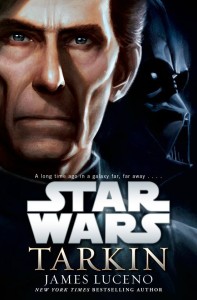 The Star Wars universe turns to view the galaxy from the other side with its second book in the new canon. Veteran writer James Luceno makes his return to the galaxy and his debut in the new canon with Star Wars: Tarkin due out on November 4th. Set five years after Revenge of the Sith, Moff Wilhuff Tarkin finds himself stationed on the remote planet overseeing the construction of what all of us know will become the fearsome Death Star. The story, of course, leaves the fledgling battle station behind as the Emperor first summons and then sends both Tarkin and Darth Vader to Murkhana to investigate Separatist communications technology.
The Star Wars universe turns to view the galaxy from the other side with its second book in the new canon. Veteran writer James Luceno makes his return to the galaxy and his debut in the new canon with Star Wars: Tarkin due out on November 4th. Set five years after Revenge of the Sith, Moff Wilhuff Tarkin finds himself stationed on the remote planet overseeing the construction of what all of us know will become the fearsome Death Star. The story, of course, leaves the fledgling battle station behind as the Emperor first summons and then sends both Tarkin and Darth Vader to Murkhana to investigate Separatist communications technology.
Without a doubt, Luceno is the master of weaving together all the pieces into one cohesive tale that makes sense of things you didn’t even realize you wanted clarity for. The time period between the trilogies has been deemed the Dark Times and rightly so as there have been relatively few stories placed in those years. Unlike Darth Plagueis, Tarkin doesn’t cover years and years of the protagonist’s life; instead covering perhaps a week supplemented with looks back into Tarkin’s formative years and moves seamlessly between the past and the present.
Tarkin is the sort of book that has Luceno’s mark upon it from start to finish and likely will not be to the taste of all readers. Luceno’s prose is denser than that of most other Star Wars authors. There isn’t an action sequence around every corner and nor is there witty dialogue or banter throughout. What Luceno does include are multiple sequences that had an absolute Hemingway-esque feel to them as Tarkin recalls his time in the Carrion during the Tarkin ritual of adulthood and survival right down to his description of killing and gutting a large animal. None of this took away from my enjoyment of the book however but I could see where it might not be to others’ tastes. It’s a book that could take a few chapters to adapt to reading.
Luceno’s grasp of his characters is masterful. His Vader feels like a Vader who is only a few years into his eternity in the suit and his Tarkin isn’t quite the man we see calmly ordering the destruction of an entire planet. Instead, we get to see the evolution of their characters. There are times where the remnants of Anakin Skywalker leak into Vader’s actions but those occasions are sparse and subtle. Luceno also poses the question that has likely been on the mind of many fans since Tarkin first appeared in The Clone Wars: Did Tarkin know Vader’s true identity? It’s an answer that’s handled as perfectly as is the creation of this Imperial power pyramid with Vader and Tarkin serving as the Emperor’s iron fists.
Speaking of Palpy, the Sheev in the room must, of course, be mentioned. In regards to the reveal in the story, it didn’t feel necessary and it seems like something Palpatine would have been more likely to reveal to Plagueis than Tarkin. As for the name itself, it makes sense. Honestly, do you think Palpatine would’ve gone for the one-name-wonder shtick if he had an appropriately imposing or imperialistic sounding first name? Of course not. Therefore, an incredibly ordinary sounding name (for Star Wars at least) makes perfect sense.
For those wondering, the Expanded Universe does not go ignored. The events of Darth Plagueis and Rise of the Dark Lord are casually referenced and I don’t think it would be a stretch to call them shadow canon. It isn’t integrated into the plot quite as much as in Luceno’s prior novels but it will likely bring a smile to the faces of Expanded Universe fans while the book remains accessible to new readers.
Overall, Tarkin is a smart and well done read that will likely have more than a few readers wanting to read it again soon to absorb every detail they missed the first time. I give Tarkin a 4/5 with a recommendation that you give it a try if you’re a fan of James Luceno, the Empire, or just plain intrigued.
Thank you to Del Rey for providing us with an advanced copy of the book for review purposes.


Pingback: Another Tarkin Mini-Excerpt Posted | Tosche Station
Pingback: Tosche Station Radio #96: Ratings and Timeslots | Tosche Station
Pingback: Tarkin Audiobook Clip | Tosche Station
Pingback: New Tarkin Excerpt Posted on the Official Site | Tosche Station
Pingback: First 50 Pages of Tarkin Posted on Suvudu | Tosche Station
Pingback: Loose Canon – Examining The Reboot, Six Months Later | Eleven-ThirtyEight
Pingback: Pick and Choose: Not Always Liking Canon | Eleven-ThirtyEight